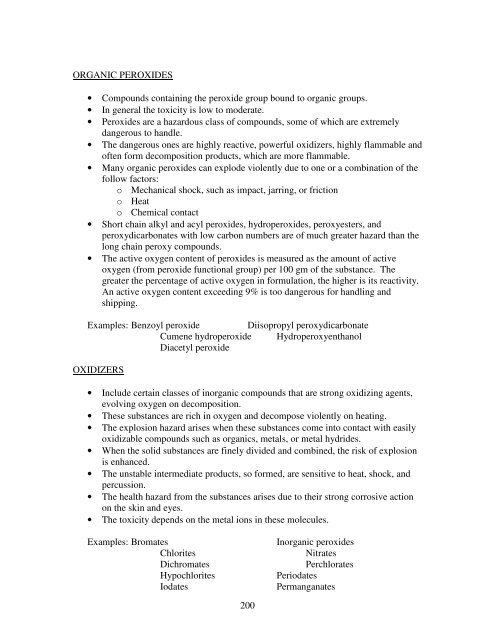Chemical Hygiene Plan - Queensborough Community College ...
Chemical Hygiene Plan - Queensborough Community College ...
Chemical Hygiene Plan - Queensborough Community College ...
You also want an ePaper? Increase the reach of your titles
YUMPU automatically turns print PDFs into web optimized ePapers that Google loves.
ORGANIC PEROXIDES<br />
• Compounds containing the peroxide group bound to organic groups.<br />
• In general the toxicity is low to moderate.<br />
• Peroxides are a hazardous class of compounds, some of which are extremely<br />
dangerous to handle.<br />
• The dangerous ones are highly reactive, powerful oxidizers, highly flammable and<br />
often form decomposition products, which are more flammable.<br />
• Many organic peroxides can explode violently due to one or a combination of the<br />
follow factors:<br />
o Mechanical shock, such as impact, jarring, or friction<br />
o Heat<br />
o <strong>Chemical</strong> contact<br />
• Short chain alkyl and acyl peroxides, hydroperoxides, peroxyesters, and<br />
peroxydicarbonates with low carbon numbers are of much greater hazard than the<br />
long chain peroxy compounds.<br />
• The active oxygen content of peroxides is measured as the amount of active<br />
oxygen (from peroxide functional group) per 100 gm of the substance. The<br />
greater the percentage of active oxygen in formulation, the higher is its reactivity.<br />
An active oxygen content exceeding 9% is too dangerous for handling and<br />
shipping.<br />
Examples: Benzoyl peroxide Diisopropyl peroxydicarbonate<br />
Cumene hydroperoxide Hydroperoxyenthanol<br />
Diacetyl peroxide<br />
OXIDIZERS<br />
• Include certain classes of inorganic compounds that are strong oxidizing agents,<br />
evolving oxygen on decomposition.<br />
• These substances are rich in oxygen and decompose violently on heating.<br />
• The explosion hazard arises when these substances come into contact with easily<br />
oxidizable compounds such as organics, metals, or metal hydrides.<br />
• When the solid substances are finely divided and combined, the risk of explosion<br />
is enhanced.<br />
• The unstable intermediate products, so formed, are sensitive to heat, shock, and<br />
percussion.<br />
• The health hazard from the substances arises due to their strong corrosive action<br />
on the skin and eyes.<br />
• The toxicity depends on the metal ions in these molecules.<br />
Examples: Bromates<br />
Chlorites<br />
Dichromates<br />
Hypochlorites<br />
Iodates<br />
Inorganic peroxides<br />
Nitrates<br />
Perchlorates<br />
Periodates<br />
Permanganates<br />
200
















